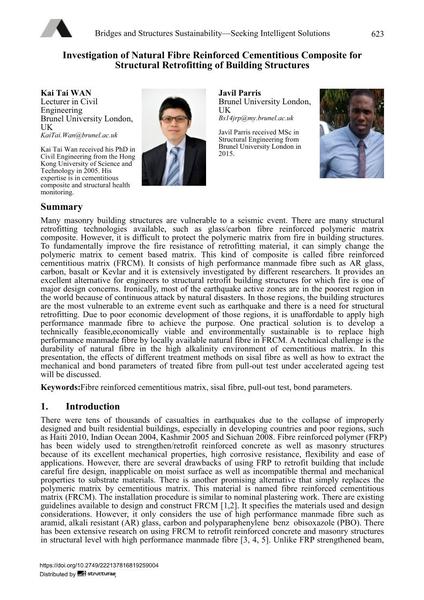Investigation of Natural Fibre Reinforced Cementitious Composite for Structural Retrofitting of Building Structures

|
|
|||||||||||
Bibliografische Angaben
| Autor(en): |
Kai Tai Wan
Javil Parris |
||||
|---|---|---|---|---|---|
| Medium: | Tagungsbeitrag | ||||
| Sprache(n): | Englisch | ||||
| Tagung: | IABSE Conference: Bridges and Structures Sustainability - Seeking Intelligent Solutions, Guangzhou, China, 8-11 May 2016 | ||||
| Veröffentlicht in: | IABSE Conference, Guangzhou, China, 8 – 11 May 2016 | ||||
|
|||||
| Seite(n): | 623-629 | ||||
| Anzahl der Seiten (im PDF): | 7 | ||||
| Jahr: | 2016 | ||||
| DOI: | 10.2749/222137816819259004 | ||||
| Abstrakt: |
Many masonry building structures are vulnerable to a seismic event. There are many structural retrofitting technologies available, such as glass/carbon fibre reinforced polymeric matrix composite. However, it is difficult to protect the polymeric matrix from fire in building structures. To fundamentally improve the fire resistance of retrofitting material, it can simply change the polymeric matrix to cement based matrix. This kind of composite is called fibre reinforced cementitious matrix (FRCM). It consists of high performance manmade fibre such as AR glass, carbon, basalt or Kevlar and it is extensively investigated by different researchers. It provides an excellent alternative for engineers to structural retrofit building structures for which fire is one of major design concerns. Ironically, most of the earthquake active zones are in the poorest region in the world because of continuous attack by natural disasters. In those regions, the building structures are the most vulnerable to an extreme event such as earthquake and there is a need for structural retrofitting. Due to poor economic development of those regions, it is unaffordable to apply high performance manmade fibre to achieve the purpose. One practical solution is to develop a technically feasible,economically viable and environmentally sustainable is to replace high performance manmade fibre by locally available natural fibre in FRCM. A technical challenge is the durability of natural fibre in the high alkalinity environment of cementitious matrix. In this presentation, the effects of different treatment methods on sisal fibre as well as how to extract the mechanical and bond parameters of treated fibre from pull-out test under accelerated ageing test will be discussed. |
||||
| Stichwörter: |
Pull-Out-Versuch
|
||||
